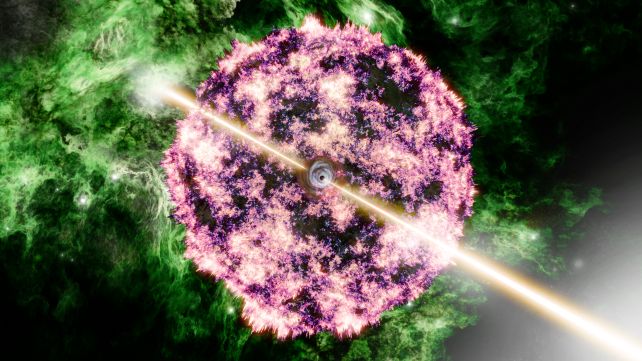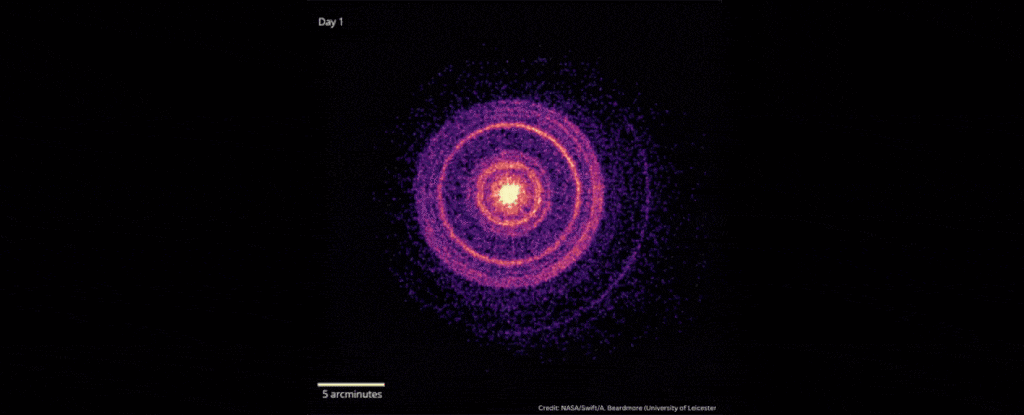In October 2022, surveys monitoring the skies for explosions in space started going off like a frog in a sock.
The reason? Something 2.4 billion light-years away spat out the biggest burst of gamma-radiation ever recorded. The event, GRB 221009A, clocked in at a record 18 teraelectronvolts and was so powerful it shook Earth's outer atmosphere.
The event, nicknamed the BOAT (for Brightest of All Time), we later determined to be the birth of a black hole from the violent death of a massive star.
Now a new analysis of the evolving light has revealed the intricacies of this explosion, and found that, for all its gamma-ray fury, the BOAT was actually surprisingly ordinary, which is not something we expected.
"It's not any brighter than previous supernovae," says astrophysicist Peter Blanchard of Northwestern University in the US.
"It looks fairly normal in the context of other supernovae associated with less energetic gamma-ray bursts (GRBs). You might expect that the same collapsing star producing a very energetic and bright GRB would also produce a very energetic and bright supernova. But it turns out that's not the case. We have this extremely luminous GRB, but a normal supernova."
Gamma-ray bursts are the most powerful explosions seen in the cosmos. They are, as the name suggests, bursts of gamma radiation – the most energetic light in the Universe – that can erupt in 10 seconds with as much energy as the Sun will emit in 10 billion years.
We know of at least two major events that can create a GRB: the formation of a black hole when a massive star goes supernova, or the hypernova accompanying the merger of two neutron stars.
The kinds of novae that produce gamma-ray bursts are also thought to be responsible for the production of heavy elements in the Universe. The thing is, heavy elements simply didn't exist until stars made them.
Stars mostly form out of the hydrogen gas abundant in the Universe, but they smash together atomic nuclei in their cores to create heavier elements. This tops out at iron, because the fusion of iron atoms sucks up more energy than it generates.
Elements heavier than iron, however, can be formed in the violent throes of a giant cosmic explosion. And we've seen it! In the aftermaths of neutron star collisions, scientists have spotted elements too heavy to form via core fusion.

But there's a lot we don't know. If we can narrow down which explosions are most likely to produce these elements, we will have a new tool for understanding not just how the Universe makes stuff, but how common such explosions are.
So, naturally, Blanchard and his colleagues wanted to take a gander at GRB 221009A to see if there were the signatures of heavy elements in the light it emitted.
But they had to wait. The explosion was so bright that it essentially blinded our instruments.
"The GRB was so bright that it obscured any potential supernova signature in the first weeks and months after the burst," Blanchard explains.
"At these times, the so-called afterglow of the GRB was like the headlights of a car coming straight at you, preventing you from seeing the car itself. So, we had to wait for it to fade significantly to give us a chance of seeing the supernova."
It wasn't until about six months after we first saw the explosion that the researchers were able to use the James Webb Space Telescope to look at the light in infrared wavelengths. This is how they were able to determine that the supernova itself was relatively normal. The reason it was so bright was likely because the jet of the gamma-ray burst was directed right at Earth.
The researchers then combined the JWST data with radio observations from the Atacama Large Millimeter/submillimeter Array to look for specific wavelength ranges consistent with the presence of heavy elements. However, while they found things like calcium and oxygen, which are fairly standard in supernovae, there was no sign of heavy element production.
Now, the rate at which neutron stars merge is not sufficient to generate the amount of heavy material we see in the Universe. Giant explosions like GRB 221009A were expected to be a contributor, but the lack of heavy elements suggests we were wrong about that.
So we need to look at other potential sources to see if we can identify the culprit, the researchers say.
"We did not see signatures of these heavy elements, suggesting that extremely energetic GRBs like the BOAT do not produce these elements," Blanchard says.
"That doesn't mean that all GRBs do not produce them, but it's a key piece of information as we continue to understand where these heavy elements come from. Future observations with JWST will determine if the BOAT's 'normal' cousins produce these elements."
The findings have been published in Nature Astronomy.
